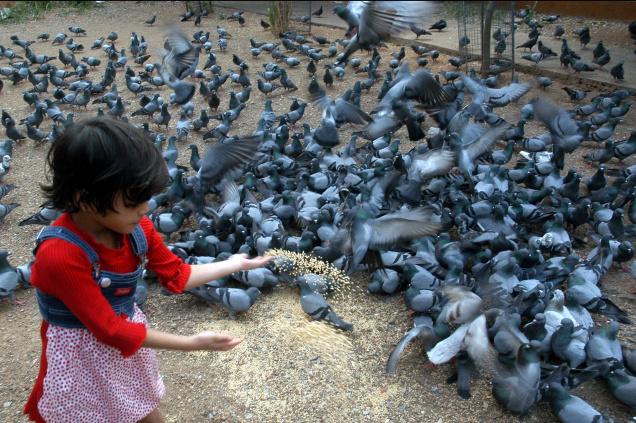
by Pigeon Patrol | Jul 6, 2023 | Bird Spike, Pigeon Spikes, Pigeons, Pigeons in the News, Raccoons, Sparrows, UltraSonic Bird Control
People often have no previous experience with pigeons or bird rescue. They did not wake up in the morning expecting to cross paths with a pigeon, but then an unexpected guest lands in their backyard, or on their roof, and it seems like something other than a random city pigeon. Perhaps it has an unusual appearance, or bands on its legs, perhaps it is alone with no flock, perhaps it seems weak or unable to fly. There’s no doubt that this is a pigeon in need of help, either because it is ill, starving, or a domestic breed lacking in survival skills. Pigeons and doves are preyed upon by hawks, ravens, gulls, cats, raccoons, rats, and more and, if you can catch the bird, she needs to be caught.
But how to catch?
First, rest assured that catching a pigeon is indeed possible, and safe- for both the bird and for you. Your catching the bird will be a lot safer for her than if a predator catches her. You will not scare a pigeon to death or give her a heart attack. And pigeons are harmless to us. They can’t really bite (no teeth and their beak is soft and weak) and, contrary to popular belief, you are highly unlikely to ever be made sick by a pigeon. There are very few diseases that you can catch from them and you are far, far more likely to get sick from a dog or cat (or be struck by lightning, actually). Simple soap-and-water hand washing after handling any animal can reduce the chances of illness to near zero.
So, let’s catch the pigeon!
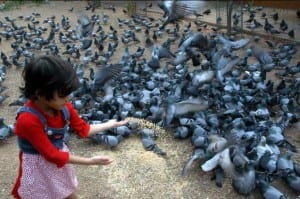
There are a few different methods that have a good success rate. Much will depend on what you are most comfortable with and what kind of shape the pigeon is in.
The first and easiest method is simply to scoop the pigeon up in your hands. People often tell us that they have found a pigeon that seems exceptionally tame and friendly and allowed itself to be picked up. If you can just pick it up, though, there’s a good chance that the pigeon is in real trouble. It may be starving, dehydrated, and/or injured.
A bird that tries to get away from you, but is weak or unable to fly, can often be walk-herded into a corner or inside through an open door and then caught (by hand or with a blanket, towel, or sweater). Drop the cloth over the bird and gently pick it up inside the cloth. Make sure the bird’s wings are folded against its sides, and hold it so that your hands encircle the wings and body, to prevent panicked flapping. A bird in this condition will likely need to be assessed by an expert.
Is your visitor lively? Flies away when you get too close? It’s good to see a strong and healthy pigeon, but this will present a challenge in actually getting your hands on the bird. The method that most often succeeds in catching a bird that is unwilling to be caught, is the crate-and-string method. You’ll need a cage or crate of some kind — a black wire dog crate works well. Put seeds and water deep in the center of the cage (beyond the reach of a clever bird who pokes her head in from the sides or back), and a thin trail of seeds leading up to the cage door (not too much, the bird needs to be hungry to risk entering what they know is a trap). Pigeons are especially fond of chopped peanuts and safflower seeds, but an ordinary bird seed mix for either pet or wild birds will work. Even rice -cooked or raw- can work in a pinch (there is a persistent myth that rice is harmful for birds, but it’s actually fine to use) or dry lentils, quinoa, crushed cereal, etc. will work for a hungry bird.
You’ll want to tie a long piece of string to the cage door in such a way as, when you pull it, the door pulls closed, and then sit at some distance, with the string in your hand. You might need to be out of the bird’s line of vision if it is particularly skittish. Eventually the bird should enter the cage to get the food, at which point you will pull on the string to close the door. Be patient. This can take some time (days even, just leave the door open when you’re not around & only put food inside so they have to go in) but is a very reliable and bird-friendly method. If the pigeon panics after the door is closed and starts thrashing around, cover the crate with a blanket to help calm her and bring the crate and bird indoors to safety. (You can’t leave her outside as predators can do terrible damage to an unsafely confined bird.) And don’t feel badly about having caught her. You most likely just saved her life and she’ll calm down.
Another method for catching a healthy unwilling pigeon is what we call the Wile E. Coyote box trap. Take a medium size box or laundry basket, turn it upside down and prop up one end with a stick. Place food and water underneath the box, with a trail leading up to it. Tie a string to the bottom part of the stick, and sit at a distance away with the other end of the string in your hand. When the pigeon ventures under the box to get the food, pull the string to remove the stick, and the box will fall, trapping the pigeon underneath.
You will at this point need to carefully reach underneath the box to get the pigeon. You won’t be able to see what you’re doing, because if you lift the box too high the pigeon will escape. You might try putting a big blanket over the box and yourself, while you try to catch the pigeon. Your neighbors will wonder about you. But it can work.
You can also buy or create a humane trap with a one-way door so that once they’ve gone in, they can’t get back out. (Monitor the trap closely though and do not leave out unsupervised or overnight. Once trapped, the bird will attract and be terribly vulnerable to predators including rats, cats, hawks, raccoons, ravens, gulls, dogs, etc.)
A third method for catching a pigeon is to find where it is roosting at night. Pigeons have very poor night vision, and tend to hold still in the dark if they sense danger approaching, hoping that it passes them by. You may be able to climb a ladder and grab the pigeon with your hands. This works best if done in the dark so turn lights off and let your eyes adjust (yours will, the pigeon’s won’t). Then very quietly and without hesitation, grab the bird with both hands around the body. Be prepared for her to startle and try to get away. Don’t let go and make that first grab count because if she gets away, she’ll risk flying off even in the dark.
The final method is one that takes a bit of practice, plus good reflexes and careful timing. It is best used on a pigeon that is hanging out with a wild flock, and it’s the method that we use for “destringing” work, when we are trying to catch wild pigeons who are suffering from injuries to their feet caused by string and debris wrapped around their toes (ever wondered why city pigeons often have missing toes or deformed feet? Now you know!) With this method, you’ll spread a generous amount of food on the ground, in a line that measures three or four inches wide and about a foot and a half long. Stand fairly close to the food with your feet spread a distance apart. The pigeons should approach and cluster around, trying to eat as much as possible and certainly more than the pigeons on either side of them. They will be eyeing the food and each other, while you stand nearby, periodically sprinkling more food. Keep your eye on the pigeon you want to catch. Slowly advance until your open hand is hovering, palm down, immediately above the pigeon, then, in one swift motion, drop your hand down, pinning the bird to the ground. It really helps to practice this multiple times, using a shoe or a loaf of bread in place of the pigeon. You’re going to be going very quickly from a standing to a crouching or lunging position, and you don’t want to topple over, so practice the motion until you feel confident.
If you try and miss, the pigeons may scatter and be skittish for a time, but overcoming their caution is sometimes just a matter of moving the food to a slightly different location. You usually get multiple chances. This is not because pigeons are stupid (they are not), but because pigeons are more trusting than most birds (and very hungry). Despite a long history of mistreatment at the hands of human beings, their species, in general, has a benevolent view of ours.
Once caught, you must bring the bird indoors to safety. The vast majority of cages are made only to confine a bird indoors and are not at all safe outside. Leaving a bird outdoors in an indoor cage is basically creating a foraging toy for predators. Hawks, raccoons, cats, rats can all do terrible damage to an unsafely caged bird, right through the bars. Once safely indoors, you need to find a pigeon-friendly expert to help you assess the bird. Many are in critical condition by the time they are caught but recognizing that and supporting them through it takes knowledge and experience.
Source
Pigeon Patrol Products & Services is the leading manufacturer and distributor or bird deterrent (control) products in Canada. Pigeon Patrol products have solved pest bird problems in industrial, commercial, and residential settings since 2000, by using safe and humane bird
deterrents with only bird and animal friendly solutions. At Pigeon Patrol, we manufacture and offer a variety of bird deterrents, ranging from Ultra-flex Bird Spikes with UV protection, Bird Netting, 4-S Bird Gel and the best Ultrasonic and audible sound devices on the market today.
Voted Best Canadian wholesaler for Bird Deterrent products ten years in a row.
Contact us at 1 877-4-NO-BIRD,(604) 585-9279 or visit our website at www.pigeonpatrol.ca
Pigeon/Pigeon Patrol / Pigeons Roosing / Vancouver Pigeon Control / Bird Spikes / Bird Control / Bird Deterrent / PIgeon Deterrent / Surrey Pigeon Control / Pest / Seagull deterrent / Vancouver Pigeon Blog / Birds Inside Home / Pigeons in the cities / Ice Pigeons / What to do about pigeons / sparrows, Damage by Sparrows, How to Keep Raccoons Away, Why Are Raccoons Considered Pests / De-fence / Pigeon Nesting / Bird Droppings / Pigeon Dropping / woodpecker control / Professional Bird Control Company / Keep The Birds Away / Birds/rats/seagull/pigeon/woodpecker/dove/sparrow/pidgeon control/pidgeon problem/pidgeon control/flying rats/pigeon problems/ bird netting/bird gel/bird spray/bird nails/bird guard
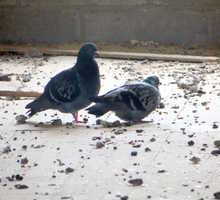
by Pigeon Patrol | Jul 6, 2023 | 4-S Gel Bird repellent, Animal Deterrent Products, Bird Deterrent Products, Bird Law, Bird Netting, Bird Spikes
First, you need to buy a pigeon trap. There are many models on the market, but most are basically large cages, with one-way entry doors.
Next, you need to set the trap in the area with the problem pigeons. You might want to wire the doors of the trap open for a few days, and set bait – cracked corn works great – in the center of the trap, and get the pigeons acclimated to feeding in the trap. Once they are used to entering the trap for the bait, you can set the trap for real. Pro Tip: Once a first pigeon enters, more will follow.
What do you do with the pigeons once you’ve trapped them? Well, you may have heard that pigeons are moderately competent at finding their way back home. Like, over oceans and stuff. They can see magnetic fields or something. So you can’t relocate them. That means you have to kill them, if you want to stop them from coming back.
Overall, it’s my opinion that pigeon exclusion methods, using spikes, electric track, or preventative netting, are the best ways to keep pigeons away for good. Far better than trapping.
Some people love to keep pigeons because they are smart, beautiful and in some cases even profitable. People will keep pigeons in pigeon coops and pigeon farms. You may not know it, but there are pigeon race competitions where people will release a pigeon away from their home and count the time it takes for the pigeon to return. Restaurants are serving pigeon as a delicacy and farms that raise pigeons are now making more and more money.
When these birds aren’t raised for pets they can become quite the nuisance, leaving droppings everywhere and causing damage to buildings. In this case they are no longer the source to relieve some stress; these pigeons are, in fact the cause of your stress. Because of this you may be looking for tips on how to trap them and if you are, you have come to the right place.
Live Traps
If you have a new pigeon problem, meaning that it started a month or two ago then you can use live traps as a way to trap the pigeons. These birds are very smart and that is why they have been trained and used by humans in many different situations from war time to the pigeon races. Because of this level of intelligence you must know what you are doing with a pigeon cage. The right bait is absolutely necessary and you can check when you purchase the cage what the best bait is. You also have to make sure that you conceal the cage to make sure that the bird does not mind going inside. Some of the best bait includes seeds that you may have purchased at your local supermarket. There is no need to get fancy when trapping pigeons.
Get Them Used to You
You will never trap the pigeons if they have no reason to come to you or into your trap. Fortunately that can be done by using corn every day. All that you have to do is get some corn and spread in the area where pigeons usually gather. When pigeons get used to the idea of getting food without actually having to hunt it or scavenge it they will keep coming back for more. Once you have them in the location every day, you want to put some of that same corn inside the cage. Now keep in mind that pigeons are fast, so you should get a trap that’s specifically designed for them. Getting another one could actually hurt the bird. These traps can be purchased at home and gardening stores everywhere and they are not harmful to the pigeons. It’s important to remove animals humanely in every situation possible.
They Will Keep Coming Back
Unless the pigeons have just found your place there is a very good chance that they will keep coming back. As mentioned before, some people make a living with pigeon races, which consists of releasing the bird and letting it find its roost. This means in addition to trapping and releasing the birds you will also need to consider what you will do to prevent them from making a roost out of your home a second time. There are many different deterrent options for pigeons. There are fences, netting and stakes that are safe and meant to keep the birds from being able to comfortably land. You will want to have a plan that uses a combination of trapping and deterrents to keep your home pigeon free.

Pigeon Trapping: How to Trap a Pigeon – Homeowners go looking for pigeon traps mostly after their pigeon problem refuses to go away with repellent interventions. Those birds just don’t know when they have overstayed their welcome and they beat the repellents every time because they’re so intelligent. For trapping, you may choose to go with either lethal or live traps.
Lethal traps
Lethal traps kills the pigeon as soon as it enters into the cage by means of a snapping or constricting mechanism. Lethal traps get rid of any pigeon captured permanently, but the intelligence of the bird is their shortcoming. When one pigeons is caught and killed, the other members of the flock will alert each other to the danger posed by the trap and none will go near it again.
The other issue with lethal trapping is that it is illegal in many areas because of its inhumane manner of getting rid of pigeons. It can also be very difficult for homeowners who are not animal control professionals, to set and use lethal traps without injuring themselves.
Live pigeon traps
The most common design of the live pigeon trap is the one-door trap. As the name suggests, it has only one door through which the pigeons enter and it is built to accommodate many birds at once. When setting this trap, know that once one pigeon enters, the others will follow. The Tomahawk Extra live pigeon trap for instance, can trap up to thirty pigeons at a time. There are also other examples like the collapsible pigeon traps. Follow the following steps to trap pigeon alive:
- Start out by getting some seed bait and spreading it out for the birds in a particular location. Repeat this over a couple of days so this eating pattern can be established for them.
- The pigeons will start returning to this spot everyday once the feeding is regular. Once this is established, get your cage ready.
- Introduce the cage trap to the location and put the seed inside it. Let them feast for another few days to gain their trust in the cage
- Set the trap to catch as many of them as possible.
As humane as live trapping seems, it is not always the best way to get rid of pigeons because after trapping and transporting them away from your abode, they are able to return to where they were captured on their own. For this reason, some people prefer to kill the birds after they’ve been trapped.
What to do after live trapping pigeons
The thing about trapping pigeons is that unlike other animals, live trapping and relocation rarely work to keep them away from your home. Pigeons are known for their amazing ability to navigate their way back home (where they roost) from anywhere they are taken to. It is this ability that made them so useful for sending communication in the olden days, and even during world wars I and II. It therefore holds that they will return to their roost spot in your house if you do trap and relocate them. It then seems that the only way to get rid of them after trapping, is to kill them; or modify your building structure to deter them from their roosting spot.
You have to decide what to do with your pigeons once you trap them – kill them or set them free. Whatever you choose, do it quickly so the pigeons do not suffer for long. If it is permitted for you to kill them where you live, do so quickly and humanely – by gassing or breaking their necks with pliers.
Bait
Traps need to be baited to attract the pigeons. Foods like grains, seeds, fruits and water, which are the birds’ favourites work best in luring them. For your trap to be effective, you should put this bait out for a period of time before actually putting it in a trap, so that the birds feel safe enough to enter your cage in large numbers.
You can use a pigeon as bait for other pigeons as well. They are social birds and are likely to perch and eat where a member of their species is, so keep a pigeon inside the cage and it will lure others in.
Source
Pigeon Patrol Products & Services is the leading manufacturer and distributor or bird deterrent (control) products in Canada. Pigeon Patrol products have solved pest bird problems in industrial, commercial, and residential settings since 2000, by using safe and humane bird
deterrents with only bird and animal friendly solutions. At Pigeon Patrol, we manufacture and offer a variety of bird deterrents, ranging from Ultra-flex Bird Spikes with UV protection, Bird Netting, 4-S Bird Gel and the best Ultrasonic and audible sound devices on the market today.
Voted Best Canadian wholesaler for Bird Deterrent products ten years in a row.
Contact us at 1 877-4-NO-BIRD,(604) 585-9279 or visit our website at www.pigeonpatrol.ca
Pigeon/Pigeon Patrol / Pigeons Roosing / Vancouver Pigeon Control / Bird Spikes / Bird Control / Bird Deterrent / PIgeon Deterrent / Surrey Pigeon Control / Pest / Seagull deterrent / Vancouver Pigeon Blog / Birds Inside Home / Pigeons in the cities / Ice Pigeons / What to do about pigeons / sparrows, Damage by Sparrows, How to Keep Raccoons Away, Why Are Raccoons Considered Pests / De-fence / Pigeon Nesting / Bird Droppings / Pigeon Dropping / woodpecker control / Professional Bird Control Company / Keep The Birds Away / Birds/rats/seagull/pigeon/woodpecker/dove/sparrow/pidgeon control/pidgeon problem/pidgeon control/flying rats/pigeon problems/ bird netting/bird gel/bird spray/bird nails/bird guard
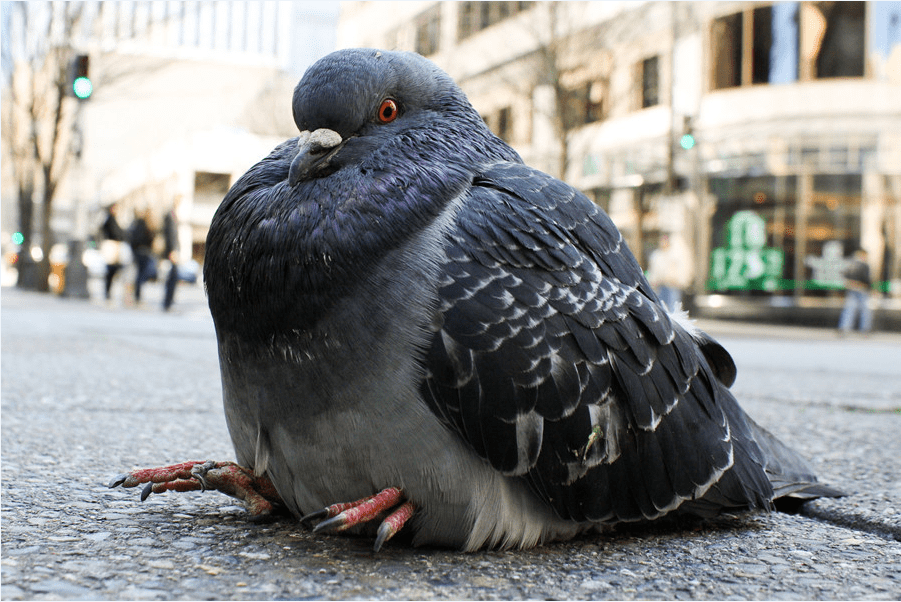
by Pigeon Patrol | Jun 30, 2023 | 4-S Gel Bird repellent, Animal Deterrent Products, Bird Deterrent Products, Bird Law, Bird Netting, Bird Spikes
Feral pigeons are the number one nuisance bird in urban areas, yet many municipalities are washing their hands of the dirty birds.
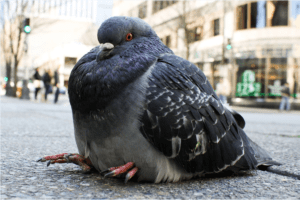
In 2013, the City of Trail, British Columbia (in the Kootenay Region of the Province’s interior) made national headlines when they scrapped a plan to relocate thousands of pigeons that plague the area to a pigeon sanctuary, only to find out that no such place exists. In the end, the city simply enacted legislation making it illegal to feed the birds and waited for them to go away.
While this sort of solution might seem appropriate to a cash strapped city council, it leaves local residents stuck with a bird problem. If you’ve got pigeons, you know how messy they can be. Their droppings cover everything underneath their resting place, and the uric acid it contains will ruin just about anything in its path. The feces can also transmit fungal, viral, and bacterial disease. They will nest in rooftop vents and air-conditioning units, causing further property damage. The long and short of the matter is that pigeons are poor roommates.
Pigeons are a year-round issue around and on homes. Roof lines provide birds with a vantage point overlooking the area surrounding your home, and most likely a regular source of food such as the neighbor’s garden. There are many other areas of the pigeons to roost such as external pipework, windowsills or worse – the chimney.
A statistic that may be the push for addressing this problem: Birds can harbor over 40 types of parasites and host internally 60 types of infectious diseases. These can be transmitted through the bird droppings found around your home.
Source
Pigeon Patrol Products & Services is the leading manufacturer and distributor or bird deterrent (control) products in Canada. Pigeon Patrol products have solved pest bird problems in industrial, commercial, and residential settings since 2000, by using safe and humane bird
deterrents with only bird and animal friendly solutions. At Pigeon Patrol, we manufacture and offer a variety of bird deterrents, ranging from Ultra-flex Bird Spikes with UV protection, Bird Netting, 4-S Bird Gel and the best Ultrasonic and audible sound devices on the market today.
Voted Best Canadian wholesaler for Bird Deterrent products ten years in a row.
Contact us at 1 877-4-NO-BIRD,(604) 585-9279 or visit our website at www.pigeonpatrol.ca
Pigeon/Pigeon Patrol / Pigeons Roosing / Vancouver Pigeon Control / Bird Spikes / Bird Control / Bird Deterrent / PIgeon Deterrent / Surrey Pigeon Control / Pest / Seagull deterrent / Vancouver Pigeon Blog / Birds Inside Home / Pigeons in the cities / Ice Pigeons / What to do about pigeons / sparrows, Damage by Sparrows, How to Keep Raccoons Away, Why Are Raccoons Considered Pests / De-fence / Pigeon Nesting / Bird Droppings / Pigeon Dropping / woodpecker control / Professional Bird Control Company / Keep The Birds Away / Birds/rats/seagull/pigeon/woodpecker/dove/sparrow/pidgeon control/pidgeon problem/pidgeon control/flying rats/pigeon problems/ bird netting/bird gel/bird spray/bird nails/bird guard
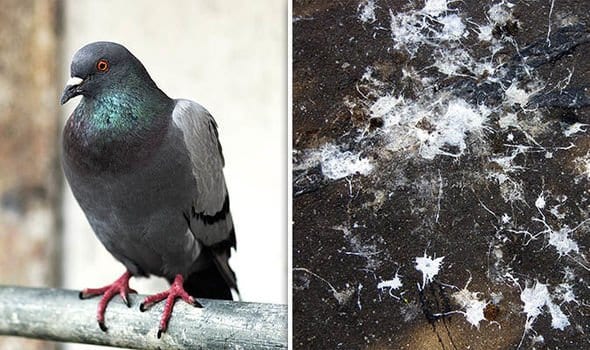
by Pigeon Patrol | Jun 30, 2023 | Bird Spike, Pigeon Predators, Pigeon Spikes, Pigeons, Pigeons in the News, Raccoons, Sparrows, UltraSonic Bird Control
If you don’t want pigeons nesting around your property, there are a number of ways you can scare them off when it looks like they might be getting comfortable.
Spray With Water
A great way to scare pigeons away without causing them any harm is to spray them with the garden hose. It’s highly unlikely they’ll appreciate getting drenched so you can guarantee they won’t hang around for long.
It’s important to do this when the birds first arrive so they know this isn’t a comfortable place to set up home. If you wait until they’ve set up a roost, not even a good soaking will get them to budge.
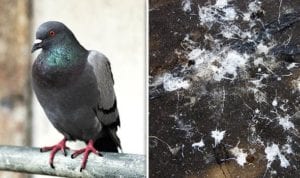
Install Scare-Pigeons
These lightweight kites are usually sold in the form of hawk silhouettes and when placed where pigeons usually roost, they’re a great scare tactic. A good tip is to move the decoy on a regular basis because pigeons will get used to its presence and won’t be scared of it anymore – especially because it doesn’t make a noise.
Use Reflective Surfaces
When the sun hits a reflective object, it creates a prism effect which interferes with pigeons’ eyesight. If your roof, balcony or windowsills are covered with anything from reflective tape to foil balloons, it’s highly unlikely they will settle. Another great way to deter pigeons from settling around your property is to hang old CDs from nearby trees or along awnings.
Install Sloped Sheathing
To keep pigeons off ledges and other flat surfaces, cover them with a sloping piece of sheet metal. If they physically can’t settle somewhere then they won’t.
When To Call A Pest Controller
The best way to deal with a pigeon problem is to call a pest controller. They will know exactly how to get rid of them and importantly, how to keep them away for good.
Pest control companies are well training on what systems to install to provide the best solution to your problem. From installing a netting system to anti-pigeon spikes, or wire systems on window ledges and leading edges.
What Won’t Work
There are many myths surrounding pigeons and how to scare them away but unfortunately, most of them are a waste of time because they simply don’t work.
- Noises – Everyone assumes that loud noises will scare these birds away but if you consider the pigeon population of London, it’s evident that this simply isn’t true. Pigeons are city birds – they’re used to loud noises and they don’t startle easily so unfortunately, no amount of noise is likely to drive them away.
- Ultrasonic Noises – Ultrasonic noise may seem like a great way to scare off pigeons but sadly, this method doesn’t work either. Ultrasonic sound waves bounce off objects, creating spots where pigeons can completely avoid the sound. Not only will you still be faced with a pigeon problem, these devices can also damage the hearing of cats and dogs.
- Ignoring the problem – Sadly burying your head in the sand won’t make these pests go away. Once they have found an Idyllic home location they will settle for life, so If left untreated the population will grow and grow, and so will the impact on your premises and surrounding area
Source
Pigeon Patrol Products & Services is the leading manufacturer and distributor or bird deterrent (control) products in Canada. Pigeon Patrol products have solved pest bird problems in industrial, commercial, and residential settings since 2000, by using safe and humane bird
deterrents with only bird and animal friendly solutions. At Pigeon Patrol, we manufacture and offer a variety of bird deterrents, ranging from Ultra-flex Bird Spikes with UV protection, Bird Netting, 4-S Bird Gel and the best Ultrasonic and audible sound devices on the market today.
Voted Best Canadian wholesaler for Bird Deterrent products ten years in a row.
Contact us at 1 877-4-NO-BIRD,(604) 585-9279 or visit our website at www.pigeonpatrol.ca
Pigeon/Pigeon Patrol / Pigeons Roosing / Vancouver Pigeon Control / Bird Spikes / Bird Control / Bird Deterrent / PIgeon Deterrent / Surrey Pigeon Control / Pest / Seagull deterrent / Vancouver Pigeon Blog / Birds Inside Home / Pigeons in the cities / Ice Pigeons / What to do about pigeons / sparrows, Damage by Sparrows, How to Keep Raccoons Away, Why Are Raccoons Considered Pests / De-fence / Pigeon Nesting / Bird Droppings / Pigeon Dropping / woodpecker control / Professional Bird Control Company / Keep The Birds Away / Birds/rats/seagull/pigeon/woodpecker/dove/sparrow/pidgeon control/pidgeon problem/pidgeon control/flying rats/pigeon problems/ bird netting/bird gel/bird spray/bird nails/bird guard
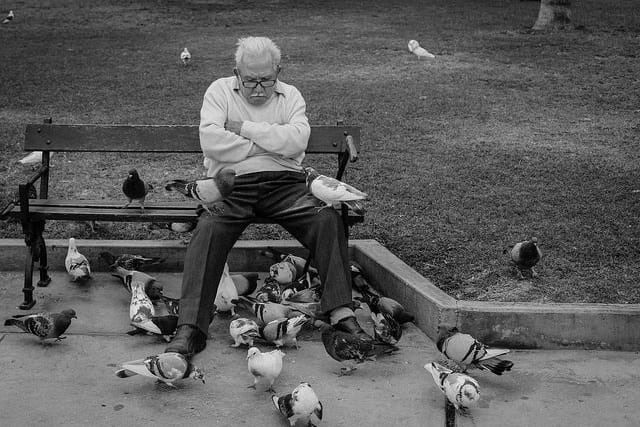
by Pigeon Patrol | Jun 30, 2023 | Bird Spike, Pigeon Predators, Pigeon Spikes, Pigeons, Pigeons in the News, Raccoons, Sparrows
From telephone wires to building ledges to public fountains, pigeons can be found nearly everywhere in a city. Unfortunately, that often means you can find them on your property, too. One pigeon may not be cause for alarm, but if pigeons have become regular visitors to your yard, you may have a problem on your hands. No homeowner wants to have to put up with these pests, but you can’t exactly just order them to leave. What should you do when you have a growing pigeon infestation? Here’s what you need to know.

How Can I Tell if I Have a Pigeon Problem?
Much of the time, pigeon infestations are impossible to miss. Pigeons are relatively large, and their sounds are difficult to ignore. If you’re away from home a lot, or if you have a large yard, it may be easier for you to overlook a burgeoning pigeon infestation. If you find feathers, nesting materials, or pigeon droppings in your yard or on your roof, it’s a likely warning sign that the pests have invaded your property.
Will Pigeons Go Away if I Leave Them Alone?
You might be tempted to ignore the issue and just hope that the pigeons will go away on their own—and, on occasion, they will. It’s more likely, however, that the pigeons will not want to leave a place where they can roost and raise families undisturbed. This means that you’ll eventually begin to see more and more pigeons until your yard is overwhelmed with the birds. As a rule, the longer you wait to deal with a pest infestation, the larger that problem will become.
Can Pigeons Do Damage to My Property?
While some birds might be a welcome presence on your property, pigeons generally are not. There are good reasons for that: Pigeons make a mess, they’re noisy, and they’re a health hazard. They can also wreak extensive—and expensive—damage on your property, including your roof, your car, and even your solar panels. They can ruin your garden or your landscaping. In other words, these pests could end up costing you a lot of money. If you have pigeons on your property, you need to do something about it as soon as possible.
Can I Solve a Pigeon Problem On My Own?
You might assume that it would be easy to get rid of pigeons. Unfortunately, it takes more than going outside and waving your arms at the birds or shouting at them to discourage them from coming back. You might temporarily scare the birds away, but they’re likely to return as soon as you go back inside. Don’t bother using popular pigeon-removal methods such as cayenne pepper—these techniques don’t work. Putting up plastic owls and other deterrents also isn’t very likely to keep pigeons out of your yard. You shouldn’t waste time with these do-it-yourself methods.
What Can I Do to Get Rid of Pigeons?
The best thing to do if you have a pigeon infestation is to call a qualified pigeon control professional. A pigeon control company can put up structures such as netting to prevent pigeons from nesting or roosting around your property. They can also clean and sanitize the areas where the pigeons were taking up residence, helping to keep you and the other members of your household safe. Finally, a pigeon control company may offer a guarantee on its services, so you won’t have to worry about the pests coming back in the future. When it comes to pigeon control, there’s no substitute for experience and professional equipment.
How Can I Prevent Pigeons from Returning?
After you’ve paid to get rid of pigeons once, it’s unlikely that you’ll ever want to have to deal with the problem again. In almost all cases, pigeon abatement is sufficient to keep the pests away. There are some other things you can do, however, to discourage pigeons from making a home on your property. Make sure al trash containers are covered, and clean up any food scraps on your patio right away. Don’t leave pet food to sit outdoors overnight. You should also look for standing water, which can attract the birds. Finally, keep an eye out for the birds and be sure to call your pigeon control company again if you see them roosting anywhere on your property.
Source
Pigeon Patrol Products & Services is the leading manufacturer and distributor or bird deterrent (control) products in Canada. Pigeon Patrol products have solved pest bird problems in industrial, commercial, and residential settings since 2000, by using safe and humane bird
deterrents with only bird and animal friendly solutions. At Pigeon Patrol, we manufacture and offer a variety of bird deterrents, ranging from Ultra-flex Bird Spikes with UV protection, Bird Netting, 4-S Bird Gel and the best Ultrasonic and audible sound devices on the market today.
Voted Best Canadian wholesaler for Bird Deterrent products ten years in a row.
Contact us at 1 877-4-NO-BIRD,(604) 585-9279 or visit our website at www.pigeonpatrol.ca
Pigeon/Pigeon Patrol / Pigeons Roosing / Vancouver Pigeon Control / Bird Spikes / Bird Control / Bird Deterrent / PIgeon Deterrent / Surrey Pigeon Control / Pest / Seagull deterrent / Vancouver Pigeon Blog / Birds Inside Home / Pigeons in the cities / Ice Pigeons / What to do about pigeons / sparrows, Damage by Sparrows, How to Keep Raccoons Away, Why Are Raccoons Considered Pests / De-fence / Pigeon Nesting / Bird Droppings / Pigeon Dropping / woodpecker control / Professional Bird Control Company / Keep The Birds Away / Birds/rats/seagull/pigeon/woodpecker/dove/sparrow/pidgeon control/pidgeon problem/pidgeon control/flying rats/pigeon problems/ bird netting/bird gel/bird spray/bird nails/bird guard









